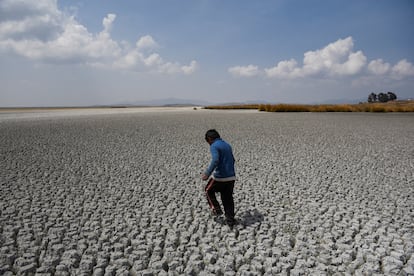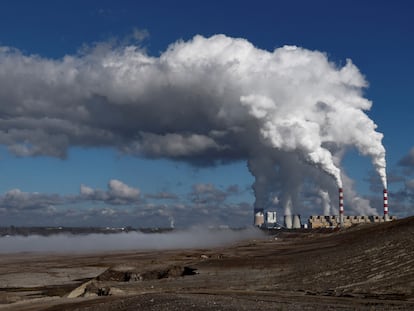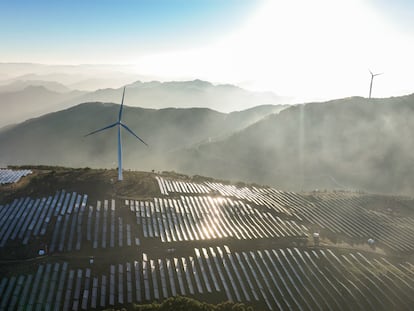An X-ray of 171 years’ worth of greenhouse gases: From those historically responsible for the climate crisis to the largest emitters today
The U.S. and EU have expelled a third of all the carbon dioxide generated by humanity since 1850. However, according to a U.N. report, China is, by far, the largest emitter today


As extreme weather events linked to the climate crisis continue, 2023 will most likely be the hottest year since at least 1850, when reliable temperature records began to be kept. 1850 is the year that’s usually taken as a reference to explain the origins of the problem of global warming, which is fundamentally linked to fossil fuels — the main cause of greenhouse emissions. These gases accumulate for decades or centuries in the atmosphere, causing global warming. It’s only after the Industrial Revolution that humans began to use coal, oil and gas on a large scale, subsequently triggering the climate crisis.
But not all of humanity is equally responsible for this phenomenon. “Contributions to climate change are unequal,” warns a report from the United Nations Environment Program (UNEP), which was published this past Monday, November 20. “A minority of countries have contributed to the majority of emissions,” the study emphasizes.
The authors — when speaking about historical responsibilities — point directly to the richest and most developed nations. “Together, the United States of America and the [nations that make up the] European Union contributed almost a third of the total accumulated emissions [of carbon dioxide, the main greenhouse gas] from 1850 to 2021.” More precisely, both powers racked up 32% of the CO₂ that was expelled during this 171-year-long period (19% overall coming from the U.S. and 13% overall from the 27 EU members). However, the third main player in this story is China, which has already generated another 13% of the world’s carbon dioxide since 1850.
The data comes from the UNEP’s Emissions Gap Report, which warns that greenhouse gases continue to increase: in 2022, they grew by another 1.2%. The authors highlight that progress has been made since the Paris Agreement was signed in 2015, although the climate plans that the world’s nations have in place will still lead to a warming of between 2.5 and 2.9 degrees Celsius, far below above the safety levels established in the pact eight years ago.
This is the 14th edition of the report that — year after year — has provided an increasingly clear picture of “past and present emissions,” explains Joeri Rogelj, one of its main authors. He’s a professor of Climate Science and Politics at Imperial College London. “Not only in terms of how many emissions are being produced globally, but also by whom and what their effect on global warming has been,” he adds. But this year is the first time the study delves into countries’ historical contributions to global warming since 1850. “This information helps us better understand the current situation,” he adds.
If we look to the past, it’s clear that the nations that were historically responsible for heavy emissions were found in what is today the G20. The current members of this group accumulated almost 80% of all the carbon dioxide that was expelled between 1850 and 2021. In addition to CO₂ emissions, the report adds another indicator: the contribution to global warming. While this is a less precise measurement compared to the case of carbon dioxide, it attempts to include the estimates of accumulated emissions of other greenhouse substances, such as methane, nitrous oxide and fluorinated gases. In this ranking, the U.S. is first once again, with 17%, followed by China (12%), the EU (10%), Russia (6%) and India (5%).
But the picture changes when current emissions are analyzed. China is, by far — and has been for two decades now — the world’s leading emitter. In 2021, according to the UNEP’s report, it was responsible for 30% of all greenhouse gases. China is followed at a great distance by the U.S. (11%), India (7%), the EU (7%) and Russia (5%).
Another useful indicator when it comes to determining the responsibility for climate change is by looking at emissions according to population. In this case, the United States and Russia — both emitting around 15 tons of CO₂ per capita in 2021 — top the list. Next is China, with just over 10 tons per inhabitant. The world average is around 6.5.
China, indeed, is behind the United States. But while the U.S. economy has reduced its emissions per capita in the last 20 years (dropping from 22.3 tons to 15.3), the Asian giant continues to increase them. Emissions per capita in China have more than doubled over the past two decades, going from 3.6 tons to 10.2. What experts fear is that this figure will continue to grow in the case of China and other developing nations such as India, the most populous nation on the planet. This seriously compromises the international fight against climate change.
“To escape poverty and develop, people need clean and safe energy,” Rogelj affirms. “Historically, the main way in which energy could be provided was [by burning] fossil fuels. [Today’s] developed countries used them a lot, which generated large amounts of greenhouse gas emissions and global warming,” the expert adds.
“The poorest countries have the inalienable right to develop and they need energy to do so,” Rogelj emphasizes, “but fortunately, today, we also have low-carbon energy options that are cheap. With the right support, the poorest countries should be able to avoid the climate mistakes of the past.”
UNEP highlights that “an increasing number of countries” have reached the “peak” of their emissions and have reduced “their absolute emissions [over the past] 10 years.” That is to say, the peak has already arrived. 36 countries are at that point — of which 22 are members of the European Union — while the other eight include high-income countries such as Australia, the United States and the United Kingdom. Six middle-income countries, meanwhile, have also reached the point of peak emissions: Albania, Cuba, Jamaica, Mexico, North Macedonia and South Africa.
Reaching that peak as soon as possible and then drastically reducing emissions is what is needed to meet the Paris Agreement. This pact — signed in the French capital in 2015 — establishes as its central objective that the increase in the global average temperature remains below two degrees Celsius (above pre-industrial levels) by the end of the century, while 1.5 would ideal.
At the moment, warming is at around 1.2 degrees Celsius. In the best case scenario, scientists propose that the 1.5 barrier will be exceeded, but then the temperatures will fall.
To achieve this, the first step is to slash emissions by 42% by 2030. But the individual climate plans of the almost 200 countries that are in the Paris Agreement will lead to a reduction of between 2% and 9%, according to estimates by the UNEP. To stay below two degrees of global warming, the cut in emissions in 2030 would have to at least be 28%… also far from what national climate plans currently propose.
The response time is running out, although countries must periodically update their climate plans. At the climate summit that begins on November 30 in Dubai — the COP28 — the first major assessment will be made. There will also be a call to more stringently reduce emissions. In 2025, all signatory nations must present their new promises. “There’s no person or economy left on the planet untouched by climate change, so we need to stop setting unwanted records on greenhouse gas emissions, global temperature highs and extreme weather,” said Inger Andersen, executive director of UNEP, in a statement released on November 20.
U.N. Secretary-General António Guterres has urged countries to strengthen their climate plans to “cover the whole economy” and “plot a course for ending fossil fuels.” Specifically, he has asked the nations that will meet in Dubai to “triple renewables capacity, double energy efficiency and bring clean power to all, by 2030.” He has also asked for the signatory nations to “commit to phasing out fossil fuels, with a clear time frame aligned to the 1.5-degree limit.”
Sign up for our weekly newsletter to get more English-language news coverage from EL PAÍS USA Edition
Tu suscripción se está usando en otro dispositivo
¿Quieres añadir otro usuario a tu suscripción?
Si continúas leyendo en este dispositivo, no se podrá leer en el otro.
FlechaTu suscripción se está usando en otro dispositivo y solo puedes acceder a EL PAÍS desde un dispositivo a la vez.
Si quieres compartir tu cuenta, cambia tu suscripción a la modalidad Premium, así podrás añadir otro usuario. Cada uno accederá con su propia cuenta de email, lo que os permitirá personalizar vuestra experiencia en EL PAÍS.
¿Tienes una suscripción de empresa? Accede aquí para contratar más cuentas.
En el caso de no saber quién está usando tu cuenta, te recomendamos cambiar tu contraseña aquí.
Si decides continuar compartiendo tu cuenta, este mensaje se mostrará en tu dispositivo y en el de la otra persona que está usando tu cuenta de forma indefinida, afectando a tu experiencia de lectura. Puedes consultar aquí los términos y condiciones de la suscripción digital.

